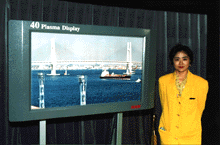
Televisions that can be hung on the wall will be
commercialized soon. This new type of television--thin with a
wide screen--is expected to come into the mainstream when
full-scale high-definition TV broadcasting begins.
Recently consumers have been purchasing bigger TV sets,
and TVs exceeding 30 inches are popular even in the home. When
HDTV broadcasting gets out of the current experimental stage
and begins in earnest, even larger screens of 40 inches or more
will be needed.
For home TVs, however, this presents problems of
weight and depth. With the present cathode-ray tube, a 40-inch
set could weigh over 100 kilograms and have a depth of nearly
70 centimeters. At 50 inches the weight would double and depth
come to nearly 80 centimeters. So NHK (Japan Broadcasting
Corporation) and electrical appliance manufacturers are racing
to develop thin, light-weight, hanging models with large
screens.
Three methods are currently being tried out for
commercializing hanging TV. The most promising is plasma
display, which NHK is applying to the development of 40-inch
screens that can handle HDTV. Some manufacturers have already
marketed personal computers with plasma displays of about 20
inches. Even a 40-inch screen would weigh between 10 and 20
kilograms and have a depth of only 6 to 8 centimeters, making
it incomparably lighter and thinner than the cathode-ray type.
The basic principle behind plasma display is the same as
that used with fluorescent lights: The ultraviolet light
emitted when neon or other gas is subjected to an electric
charge is beamed on fluorescent material, which emits light.
This method is easier to understand if it is thought of in
terms of more than a million tiny fluorescent lights in three
basic colors, red, green, and blue, being packed into the
screen. The timing, duration, and brightness of each light is
controlled by microcomputer, creating the overall image.
A number of manufacturers have already announced plans
for commercialization, and models are expected to go on the
market sometime in 1996. In the beginning prices will probably
be over 1 million yen for the 40-inch model, but the
manufacturers say they want to halve this price through mass
production.
(The above article, edited by Japan Echo Inc., is based on domestic Japanese news sources. It is offered for reference purposes and does not necessarily represent the policy or views of the Japanese Government.)